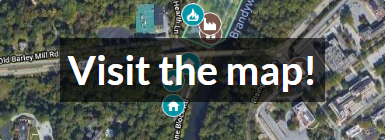Some of the many places named in the interviews about the Brandywine community will be familiar to us today, while others remain primarily as memories or references in books.
To better understand these Brandywine places, Hagley staff have compiled a map showing the known locations of neighborhoods, schools, churches, workplaces, and other noteworthy places frequently mentioned in the Brandywine Oral Histories.
As you explore the map, listen to Edward B. Cheney, an interviewee born in 1888, poignantly describe the region in a poem he wrote entitled "Up Along the Brandywine."
Click here to listen to the full interview
The maps and documents used to locate places on the map can be found at the bottom of the page. If you have questions or suggestions of other places of prominence we should include, please email us at askhagley@hagley.org.
The list below includes a curated selection of material relating to Brandywine places available online via Hagley's digital archives and digital exhibits. If you have any questions, please contact us at AskHagley@hagley.org
19th Century Community Stores : Report from 1989 that uses the Brandywine oral histories to summarize the importance of and activities surrounding community stores in the 19th century.
A Brief Outline History of Breck's Mill : Timeline covering a period from 1684 to 1970 that emphasizes ownership and uses of Breck's Mill.
A Brief Outline History of Walker's Mill : Narrative summary of Walker's Mill with emphasis on ownership and production activity.
Along the Brandywine : Book written by Delaware State Representative, Frank Zebley, in 1940 that chronicles the landscape, history, and people along the Brandywine Creek in Delaware and Pennsylvania.
Brandywine Reminiscences : A compilation of recollections from John Macklem who started working for DuPont in the 1880s and remained with the Company his entire life. Macklem recounts operations of the company and memories of specific people. Information appears to have been compiled in 1936, Macklem died in 1948.
Brandywine Valley oral history interviewees' photographs : Photographs collected from oral history participants.
Delaware's Industrial Brandywine digital exhibit : An exhibit developed to document businesses from the 17th to 20th centuries that benefited from the unique geography of the Brandywine Creek along its eight-mile stretch in Delaware.
DuPont Company Brandywine powder yards and neighboring worker communities' photographs : Collection of images related to the Brandywine Valley including archaeology and excavation during the early years of the Hagley Museum.
The DuPont Company on the Brandywine digital exhibit : Exhibit focusing on the DuPont Company during its era as a black powder production facility from 1802 to 1921.
The E.I. du Pont de Nemours and Company's Housing of its Workers : Thesis by Mott R. Linn from 1983 that used publications and records from the Hagley Library.
For it's Always Fair Weather : Sketches of old taverns of the Brandywine vicinity : Pamphlet authored by DuPont family member, W.W. Laird, in 1978 that includes descriptions and images of know taverns in the Brandywine Valley area.
Hagley area and Charles Copeland estate photographs : A small but significant collection of photographs that includes images of DuPont Powder Yards and surrounding area circa 1900.
The Industrial Worker Along the Brandywine, 1840-1870
The Industrial Workman along the Brandywine, 1870-1902 : Two part report done in 1957 and 1958 about the 19th-century labor force along the Brandywine Creek with a particular focus on workers at the DuPont Company Powder Yard.
Interpretive Packet on Explosions : Listing of every documented explosion at the DuPont Company Powder yards from 1807 to 1921 along with a list of workers killed in specific explosions.
John W. Macklem collection of DuPont Company powder yards photographs : Collection of photographs extensively annotated by John Macklem (1867-1948), who spent his entire career with DuPont. The photographs depict the landscape and buildings at the DuPont's Brandywine Works in the early twentieth century.
Life and Work in the Powder Mills : An article published in McClure's Magazine in 1895 describing various aspects of black powder production at the DuPont Brandywine powder yards as well as the landscape of the yards and surrounding worker villages.
Maps and Plans of the Hagley Site and Buildings : A selection of maps, largely dating to the first two decades of the twentieth century, of the Brandywine Works of E.I. du Pont de Nemours & Company, now the site of Hagley Museum and Library.
Pierre Gentieu Collection of Brandywine River Valley Images, 1880 - 1920 : Photographs taken by Pierre A. Gentieu (1842-1930), a long-term employee of E.I. du Pont de Nemours & Company. This collection constitutes the most important surviving visual record of the DuPont Company's Hagley Yards during the late nineteenth and twentieth centuries, when the manufacture of black powder peaked and began to decline with the development of high explosives.
Scenes on the Brandywine : Illustrated article published in Harper's Weekly in 1889 describing the picturesque qualities of Brandywine Creek.
Workers' Communities along the Brandywine : A 1984 report outlining basic details and history of the various named worker neighborhoods near the DuPont Brandywine powder yards.
Workers Homes and Furnishings in DuPont's Banks, 1870-1920 : A 1981 report focusing on interior furnishings and their influences in the worker communities near the DuPont Brandywine powder yards.
The Workers' World at Hagley : Publication by Glenn Porter, created in conjunction with a 1981 Hagley Museum exhibit, featuring quotations from the Brandywine Valley oral histories alongside photographs from the Pierre Gentieu Collection of Brandywine River Valley Images.


